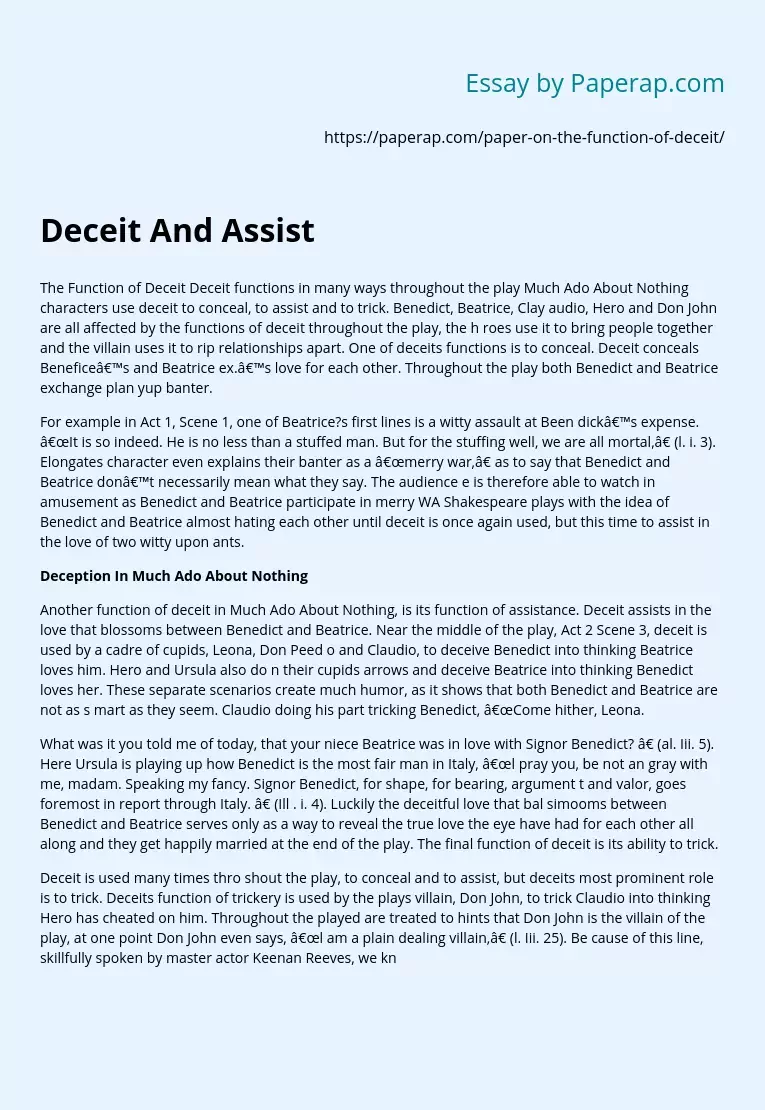Deceit And Assist
The Function of Deceit Deceit functions in many ways throughout the play Much Ado About Nothing characters use deceit to conceal, to assist and to trick. Benedict, Beatrice, Clay audio, Hero and Don John are all affected by the functions of deceit throughout the play, the h roes use it to bring people together and the villain uses it to rip relationships apart. One of deceits functions is to conceal. Deceit conceals Benefice’s and Beatrice ex.’s love for each other.
Throughout the play both Benedict and Beatrice exchange plan yup banter.
For example in Act 1, Scene 1, one of Beatrice?s first lines is a witty assault at Been dick’s expense. “It is so indeed. He is no less than a stuffed man. But for the stuffing well, we are all mortal,” (l. i. 3). Elongates character even explains their banter as a “merry war,” as to say that Benedict and Beatrice don’t necessarily mean what they say. The audience e is therefore able to watch in amusement as Benedict and Beatrice participate in merry WA Shakespeare plays with the idea of Benedict and Beatrice almost hating each other until deceit is once again used, but this time to assist in the love of two witty upon ants.
Deception In Much Ado About Nothing
Another function of deceit in Much Ado About Nothing, is its function of assistance. Deceit assists in the love that blossoms between Benedict and Beatrice. Near the middle of the play, Act 2 Scene 3, deceit is used by a cadre of cupids, Leona, Don Peed o and Claudio, to deceive Benedict into thinking Beatrice loves him.
Hero and Ursula also do n their cupids arrows and deceive Beatrice into thinking Benedict loves her. These separate scenarios create much humor, as it shows that both Benedict and Beatrice are not as s mart as they seem. Claudio doing his part tricking Benedict, “Come hither, Leona.
What was it you told me of today, that your niece Beatrice was in love with Signor Benedict? ” (al. Iii. 5). Here Ursula is playing up how Benedict is the most fair man in Italy, “l pray you, be not an gray with me, madam. Speaking my fancy. Signor Benedict, for shape, for bearing, argument t and valor, goes foremost in report through Italy. ” (Ill . i. 4). Luckily the deceitful love that bal simooms between Benedict and Beatrice serves only as a way to reveal the true love the eye have had for each other all along and they get happily married at the end of the play. The final function of deceit is its ability to trick.
Deceit is used many times thro shout the play, to conceal and to assist, but deceits most prominent role is to trick. Deceits function of trickery is used by the plays villain, Don John, to trick Claudio into thinking Hero has cheated on him. Throughout the played are treated to hints that Don John is the villain of the play, at one point Don John even says, “l am a plain dealing villain,” (l. Iii. 25). Be cause of this line, skillfully spoken by master actor Keenan Reeves, we know that the character re Don John ill be messing a lot of stuff up later on in the play.
And Don John does mess up stuff, in Act 3 Scene 2, Don John speaks with Claudio, saying, “l came hither to tell you; and, circumstances shortened, for she has been too long talking of, the lady is disloyal. ” (al. Ii. 5). D on John then shows both Claudio and Don Pedro that ‘Hero’ is being unfaithful with Bronchi o, when in fact Broacher is only wooing Margaret, one of Hero’s maids. This act of trickery me sees up everything, Claudio and Don Pedro confront Hero at the wedding in front oft he entire congregation.
After the wedding Don John flees Messing and everyone finds o UT that Hero was falsely accused, thanks to Dogberry, who captured Broacher and his part near in crime Conrad. The function of deceit is a quintessential part of Much Ado About Nothing . Deceit is used to conceal, to assist and to trick many of the main characters throughout t the entirety of the play. The epitome of deceit in William Shakespearean capering comedy, air manically, is the moment when Benedict and Beatrice deceptive protests against their love f or each other are foiled by their own hands.
Deceit And Assist. (2019, Dec 05). Retrieved from https://paperap.com/paper-on-the-function-of-deceit/

